6 Moveworks Alternatives & Competitors for 2025
More and more businesses are leveraging AI within mission-critical internal workflows. This includes a range of internal services across IT, finance, HR, operations, and other departments.
To meet this need, a range of vendors have come to the fore, offering streamlined tools for implementing LLM-powered processes.
Today, we’re exploring one practical angle on this by checking out some of the top Moveworks alternatives that are currently available on the market.
Moveworks is fast becoming one of the key players under the agentic AI umbrella, with a particular focus on ITSM use cases within large enterprise environments.
In this guide, we’ll cover everything you need to know to determine which platform in this space is right for your specific needs, including:
- What is Moveworks?
- Who uses Moveworks?
- Why would you need a Moveworks alternative?
- Top 6 Moveworks alternatives in 2025
Let’s jump right in.
What is Moveworks?
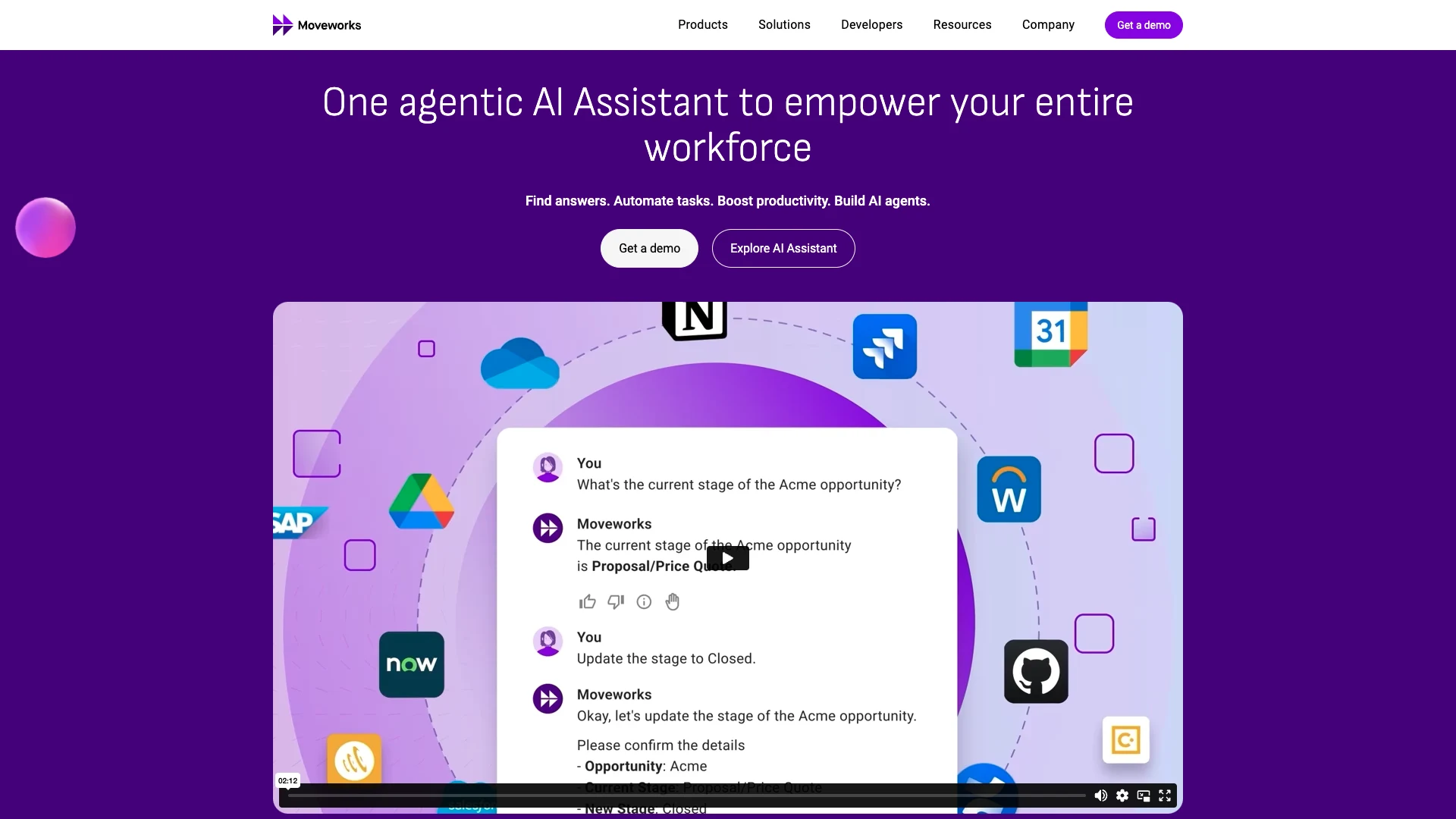
(Moveworks Website)
Moveworks is an agentic AI platform that enables teams to create custom solutions for managing internal processes. This centers around capabilities for building conversational assistants for a whole host of services and functions.
The goal is to provide a single point of contact for end users to access agreed services via purpose-built chatbots or existing communications tools. In turn, this reduces burdens on service teams while also enhancing end-user experiences.
This works by furnishing developers with reusable tools for connecting LLMs to external applications, data, information resources, and APIs. That way, we can create agentic solutions that can accept inputs, perform reasoning, and take action autonomously.
For example, receiving a support query, searching the relevant knowledge entries and recent tickets for context, and taking action within your ITSM platform to resolve the underlying issue.
This positions Moveworks as a powerful, flexible solution for building AI layers over existing systems.
Who uses Moveworks?
As we said a second ago, Moveworks is an increasingly popular platform for enterprise teams, as well as smaller orgs that want to build efficiency into internal processes.
However, it’s worth drilling deeper into this, especially in terms of the underlying characteristics of these teams and the pain points Moveworks can alleviate.
Moveworks is highly suited to teams with complex internal service portfolios, relying on multiple separate but interconnected systems. For instance, ITSM, HRIS, CRM, ERP, and other department-specific platforms.
There are a couple of key challenges that stem from this. Firstly, maintaining integration across distributed systems like this causes huge difficulties, including relating to consistency, authorization, reliability, and security.
Secondly, the UX for service users can suffer, especially in terms of understanding how to initiate individual workflows.
Moveworks alleviates this by acting as a centralized, AI-driven platform that abstracts away the complexity of traditional automations.
In terms of more granular personas, Moveworks is popular among a range of IT professionals, including systems engineers, developers, solutions architects, and more.
While it doesn’t necessarily require full-on development expertise, it’s useful to have an awareness of certain things, such as working with APIs, identity and access management frameworks, and how underlying systems like ITSM or HRIS platforms are configured.
Why would you need a Moveworks alternative?
However, as we alluded to earlier, this is a fast-moving, increasingly crowded space. As with any software procurement decision, it’s important to be aware of the more specific strengths, weaknesses, and target personas of our specific options for Moveworks alternatives.
That is, individual platforms are optimized for their own distinct use cases, users, and environments.
So, what are the key points we’ll need to consider here?
One that we’ve hinted at already is what’s required in terms of technical skills. That is, some platforms are aimed at more technical colleagues than others. Some non-IT colleagues may find that other platforms better suit their needs.
On the flip side, other teams, especially those with more extensive, AI-specific skills, might find that Movework’s approach doesn’t offer sufficient flexibility for their needs.
Similarly, certain platforms may be better optimized for individual use cases or internal functions, including across out-of-the-box workflows and integration options.
This could relate to a few key clusters of capabilities. For instance, teams building highly advanced agentic solutions might require greater control over prompt engineering, model selection, memory management, or general customization than Moveworks currently supports.
Licensing is also an obvious consideration.
One element of this is pricing. In simple terms, some teams may find that certain Moveworks alternatives can more cost-effectively meet their needs.
Additionally, many large organizations prioritize open-source solutions, especially for mission-critical tools. So, they might opt for an alternative platform with an open-source license.
Take a look at our round-up of the top open-source AI agent platforms to learn more.
Top 6 Moveworks alternatives in 2025
Now that we have a clearer idea of exactly what we might be looking for, we can begin to consider some of our specific options from across the market.
As we’ve seen already, there are some important distinctions between tools here that cater to more specific segments. To give a balanced view of what’s available, we’ve selected options that take somewhat different approaches to solving many of the same underlying pain points.
So, some of these are direct Moveworks competitors. Others comprise more technically-focused AI platforms, traditional workflow automation tools, or use-case-specific solutions such as ITSM platforms that offer AI capabilities.
You might also like our guide to choosing a no-code AI agent builder.
Our picks are:
Here’s a summary of where each one sits in the market.
Let’s check them out individually in more detail.
1. Aisera
First up, we have Aisera. One of Movework’s most direct competitors, this is a purpose-built agentic AI platform with a specific focus on automating internal processes across IT, HR, finance, and operations departments.
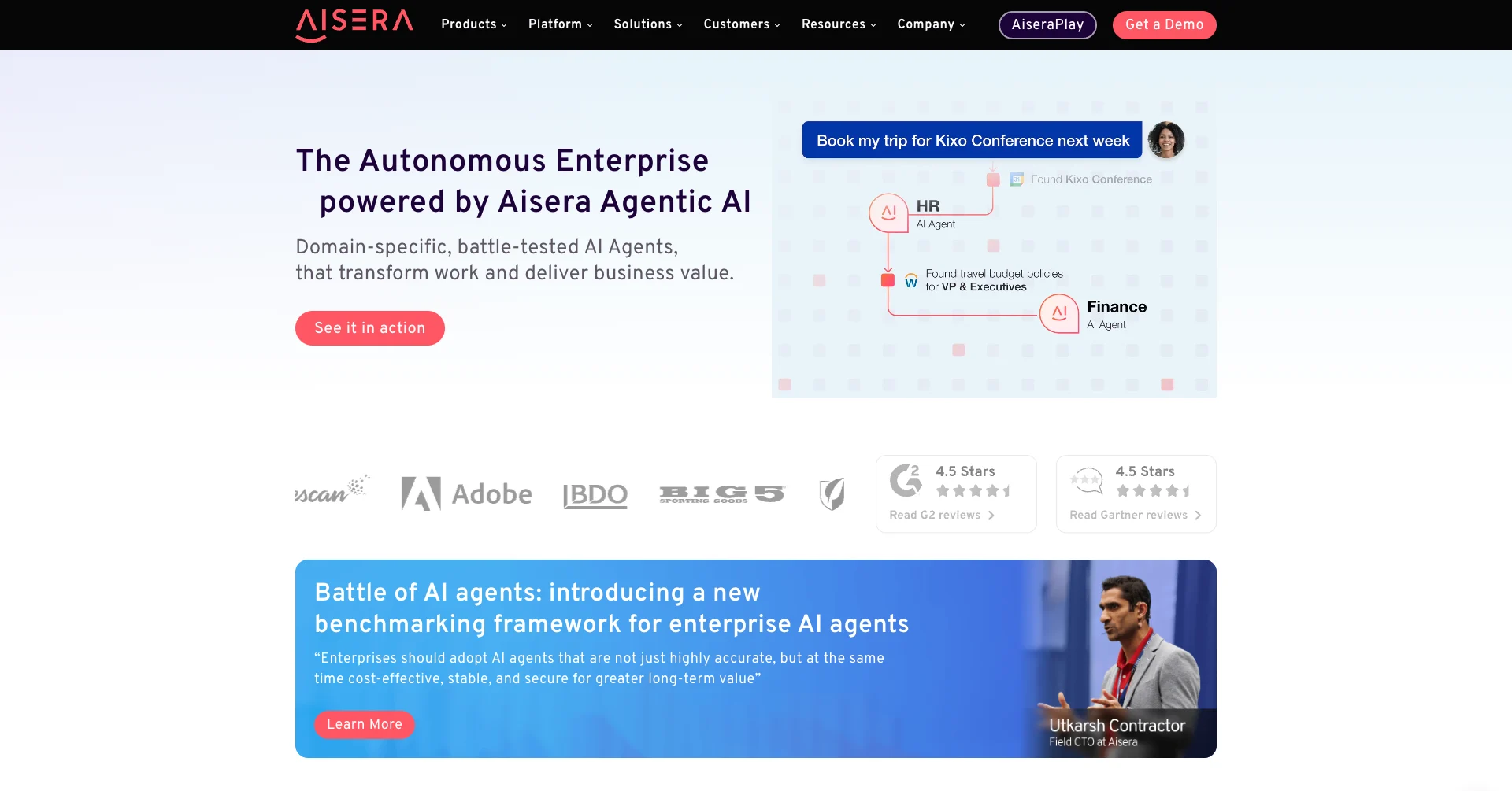
(Aisera Website)
Pros
Like Moveworks, Aisera’s focus is on empowering teams to build AI agentic workflows that utilize their existing internal systems, tools, and data assets. As part of this, it offers extensive connectivity for a huge range of enterprise applications, out of the box.
The core flow for building agents is to facilitate rich automation logic while minimizing development overhead. This includes tools to define intents, connect data, and configure workflows using visual development experiences.
Aisera is also particularly strong on pre-built, ready-to-use workflows. It offers a range of pre-configured use cases, such as password resets, access provisioning, and benefit enquiries. This could help teams with lower technical resources reach time to value more quickly.
Cons
However, there are some important downsides to Aisera, too. One consideration here is that it’s generally a fairly enterprise-focused platform.
For instance, its integration options are extensive but potentially more skewed towards large organizations.
Lastly, like Moveworks, Aisera is a closed-source platform, so teams that prioritize open-source tools may wish to look elsewhere.
Pricing
Aisera’s pricing is not publicly advertised.
Instead, license costs are calculated on an individual basis, depending on the requirements of specific organizations.
This may include factors such as user volumes, the number of AI agents we need, requirements for specific modules, support arrangements, and more.
2. Resolve Systems
Resolve Systems is another enterprise IT-focused platform. It offers a suite of tools for automating and orchestrating IT operations processes, especially for incident management and problem resolution.
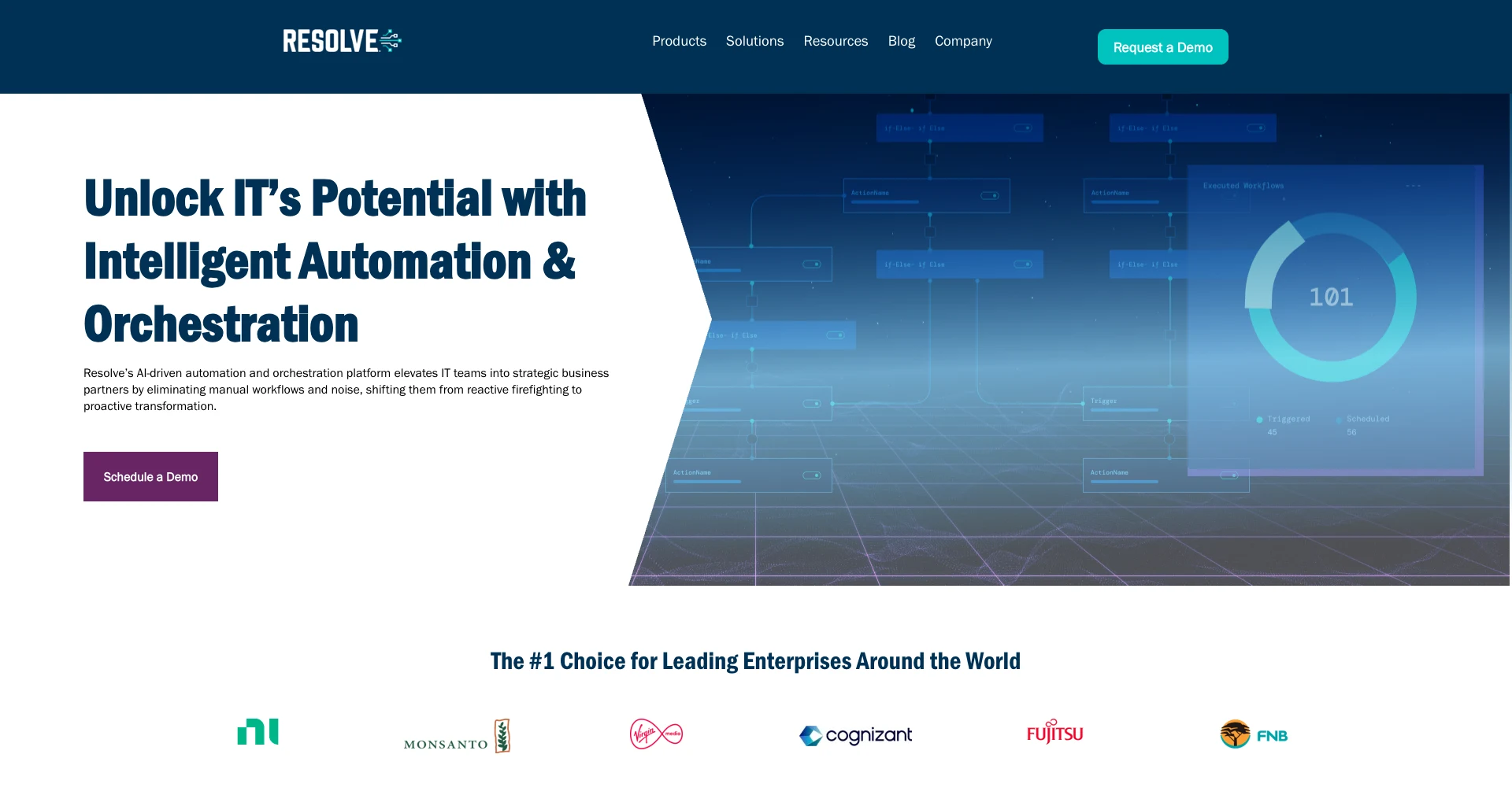
(Resolve Website)
Pros
Resolve’s core selling point is offering a comprehensive, end-to-end solution for incident and problem management. This includes advanced tools for monitoring, detection, triage, resolution, and reporting.
It’s also highly effective in terms of automation capabilities, with a visual workflow designer, pre-built actions, reusable modules, custom scripting, and AI-powered incident analysis. We can even insert manual approval checkpoints for human-in-the-loop workflow automation.
Resolve Systems also integrates seamlessly with a wide range of common ITSM solutions, including ServiceNow and BMC tools. This empowers organizations to bridge manual service operations with intelligent automation.
Cons
One potential limitation of Resolve Systems is its tight focus on ITSM and ITOps processes. For teams that want to build more unified service management automations across a broader range of functions, other Moveworks alternatives may be more suitable.
Some users report that Resolve Systems can offer a comparatively steep learning curve.
It’s a highly feature-rich platform aimed at technical teams, so additional time may be beneficial to get up and running.
Pricing
As another enterprise-centric platform, Resolve’s pricing is entirely based on custom quotes, as opposed to some other platforms that offer fixed pricing tiers.
Again, this likely draws on a range of usage-based, functional, and non-functional requirements, including user volumes, support arrangements, and specific required features.
As with any custom enterprise pricing, you’ll need to contact Resolve Systems to get a realistic quote to compare to other Moveworks alternatives.
3. Freshservice + Freddy AI
As a more comprehensive, end-to-end ITSM platform, Freshworks is a somewhat different proposition to some of the other platforms we’ve seen so far. However, it also offers a range of AI-powered capabilities that make it an interesting proposition in this space.
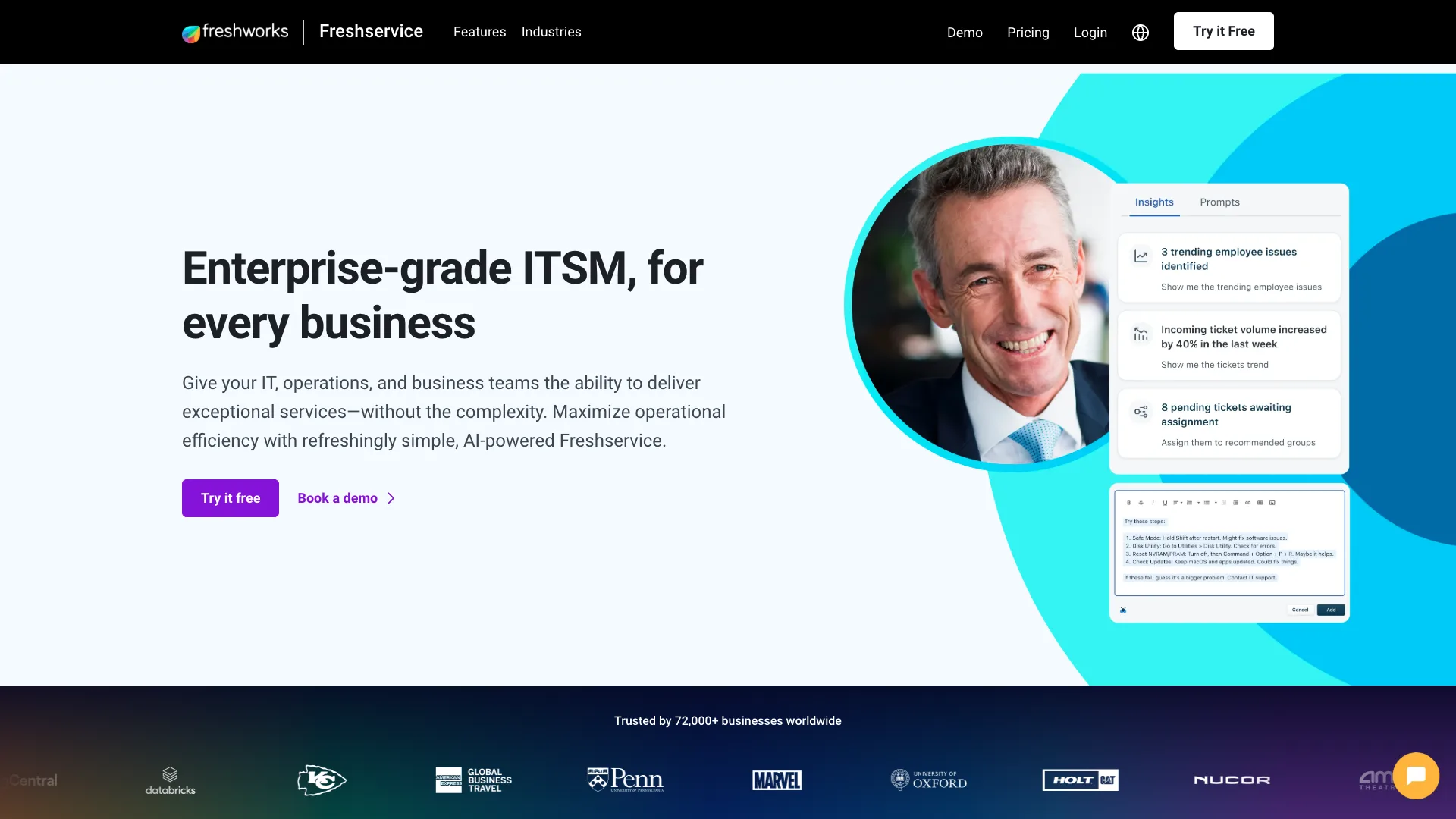
(FreshService Website)
Pros
Freshservice is a full-featured ITSM platform aimed at teams that need to build efficiency across the whole of their service portfolios. This includes a range of AI capabilities across agent assistance, custom chatbots, workflow automations, and response generation, under the Freddy AI umbrella.
It’s an attractive option for a wide range of teams, offering a flexible yet user-friendly platform, without necessarily requiring extensive technical skills or resources to create usable solutions for AI-powered workflows via low-code experiences.
Freshservice is also highly extensible, boasting a large marketplace of native integrations, third-party apps, and more, making it a great fit for teams that need to add bespoke functionality within ITSM flows.
Cons
Of course, an important consideration here is the fact that Freshservice isn’t a standalone AI agent platform. So, to take advantage of many of its selling points, we’d need more widespread adoption using it as our ITSM platform.
Similarly, we may find that as an ITSM tool with AI functionality, it lacks some of the more granular features we’d see in the likes of Aisera or Moveworks. For example, for performing more complex agent orchestration.
Additionally, as we’ll see in a moment, many of Freshservice’s AI features are restricted to more expensive pricing tiers, which means this may not be a viable option for all teams.
Pricing
Freshservice offers a flexible, transparent pricing structure that could be suitable for a wide range of teams. These are billed on a per-agent per-month basis, starting from $19 and ranging up to custom enterprise quotes.
However, it’s important to note that Freddy AI isn’t available across the board. We get this as standard on enterprise plans, but it’s also available as an optional add-on for the Pro license, adding around $20 to the existing $99 per agent per month bill.
Naturally though, comparing the cost-effectiveness of this versus other Moveworks alternatives will be a highly situation-specific decision, given the somewhat different scope of the platform itself.
4. Rasa
Next, we have Rasa. This is an open-source conversational AI framework aimed at teams that need a high degree of control over the design, deployment, and behavior of AI assistants.
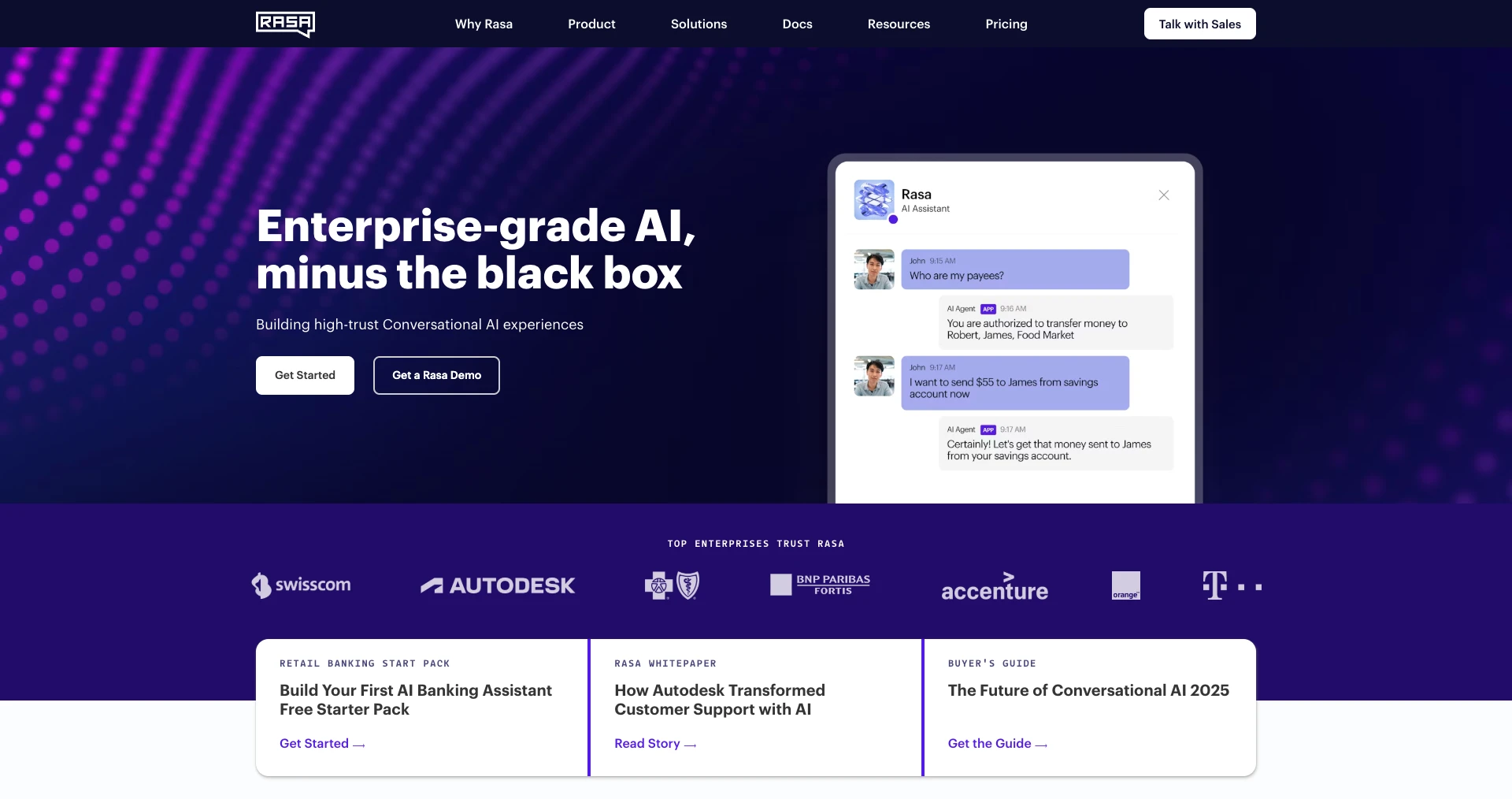
(Rasa Website)
Pros
As an open-source framework, Rasa is designed to empower developers to build highly customized solutions, with complete control over logic, pipelines, and data handling. This makes it well-suited to highly regulated environments and more niche use cases.
In particular, it’s a strong choice for teams that require a high level of granularity over natural language understanding pipelines, dialog management policies, integration with external data, and more.
Rasa is also self-hostable, making it an ideal choice for teams with stringent security or data governance requirements.
Cons
One potential downside of Rasa is that it’s aimed at a somewhat more technical target persona. Therefore, we may need a greater understanding of the underlying concepts for AI development compared to some other platforms.
However, to help overcome this, there’s also Rasa Studio, a collaborative no-code solution for building AI assistants.
Similarly, there’s an operational and maintenance overhead that comes with self-hosting solutions, which will need to be accounted for. However, it’s worth noting that Rasa is also available as a managed service.
Pricing
Rasa offers a range of license tiers, taking into account conversation volumes and the number of bots we require, specific functionality, and support requirements. There’s a free developer edition, which enables us to build a single bot.
Paid licenses start at $35,000 per year for up to 500,000 conversations, as well as access to Rasa Studio and other features, including RBAC and SSO.
Custom enterprise licenses are also available with enhanced security tools and support arrangements.
5. n8n
Next up, we have n8n, one of the best-known workflow automation platforms on the market. As with many tools in this space, it’s launched a range of capabilities in the past few years for building AI-powered workflows.
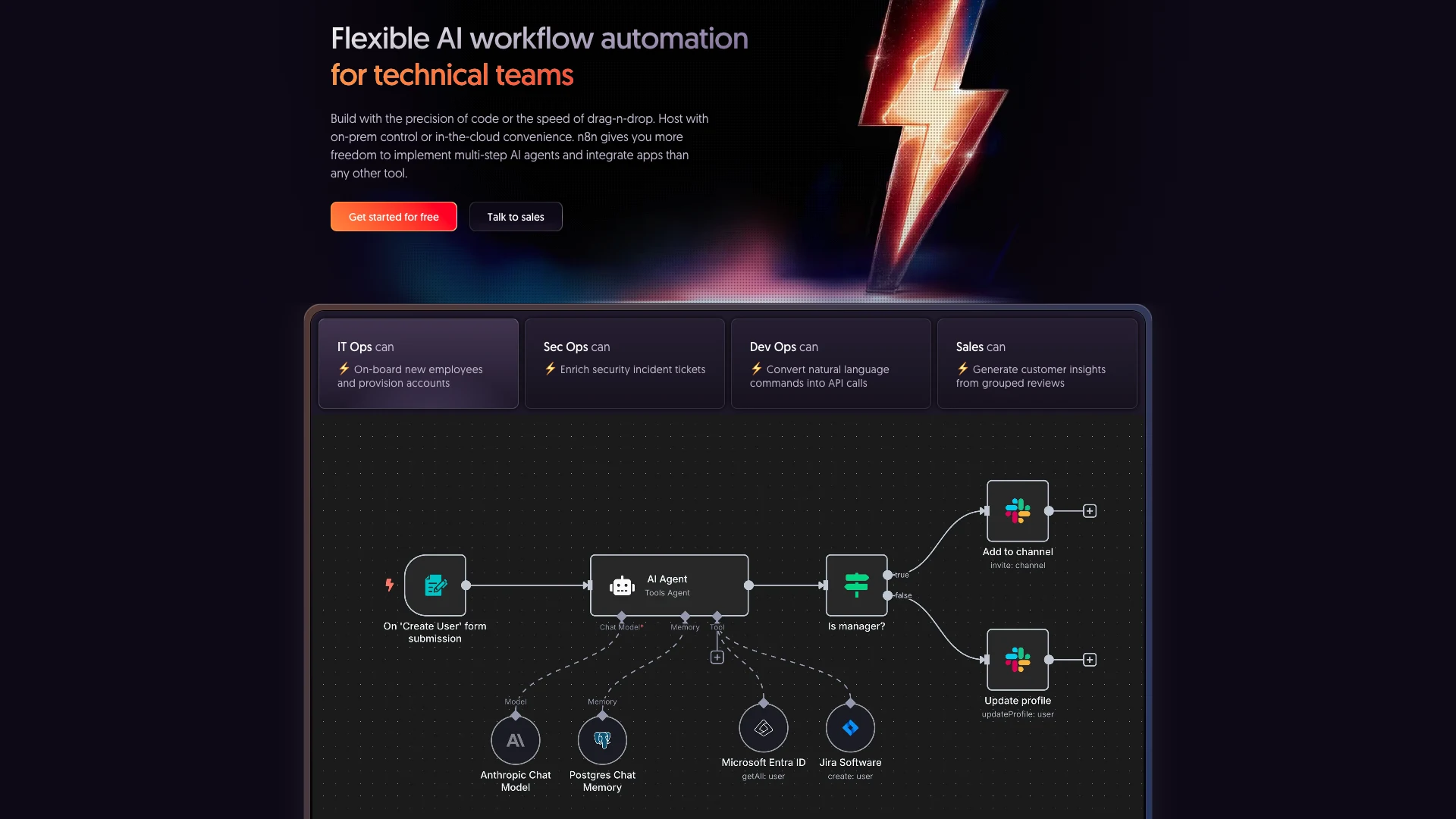
(n8n Website)
Pros
Arguably, n8n’s greatest strength is its powerful, intuitive experiences for building automation rules visually. This centers around a drag-and-drop experience for building logic and creating agents, with fully optional scripting.
It also offers extensive connectivity for a huge range of models, memory stores, third-party tools, and more, making it a great choice for building AI-driven workflow solutions for a huge range of use cases.
On top of this, n8n is source-code-available and offers self-hosting via VPSs, virtual machines, and a range of cloud tools, which is naturally a firm requirement for many security-conscious teams.
Cons
However, it’s important to note that while n8n is a highly powerful solution, it wasn’t built from the ground up for AI use cases. So, some teams might find that more advanced features for tasks like orchestration, memory handling, and long-running autonomy are more effective in other platforms.
Despite its low-code underpinnings, it’s still helpful to have an awareness of certain technical subjects such as data flows and API usage in order to be successful with n8n.
Additionally, some users report that without following best practices, n8n’s visual interface can become cluttered when dealing with complex workflows. This may increase the learning curve if we want to maximize ease of maintenance.
Pricing
n8n’s pricing follows a per-run model, which means it could potentially be a highly scalable, affordable option for many use cases.
However, there are a couple of important things to be aware of here. Paid plans start from $24 per month, with 2,500 executions. We can also access more expensive licenses to increase usage limits or add premium features like global variables and workflow histories.
A customer enterprise license will be needed for SSO, Git-based version control, or extended data retention.
6. OpenDialog
Lastly, we have OpenDialog, a platform aimed at teams that need to build, manage, and scale AI agents safely and transparently.
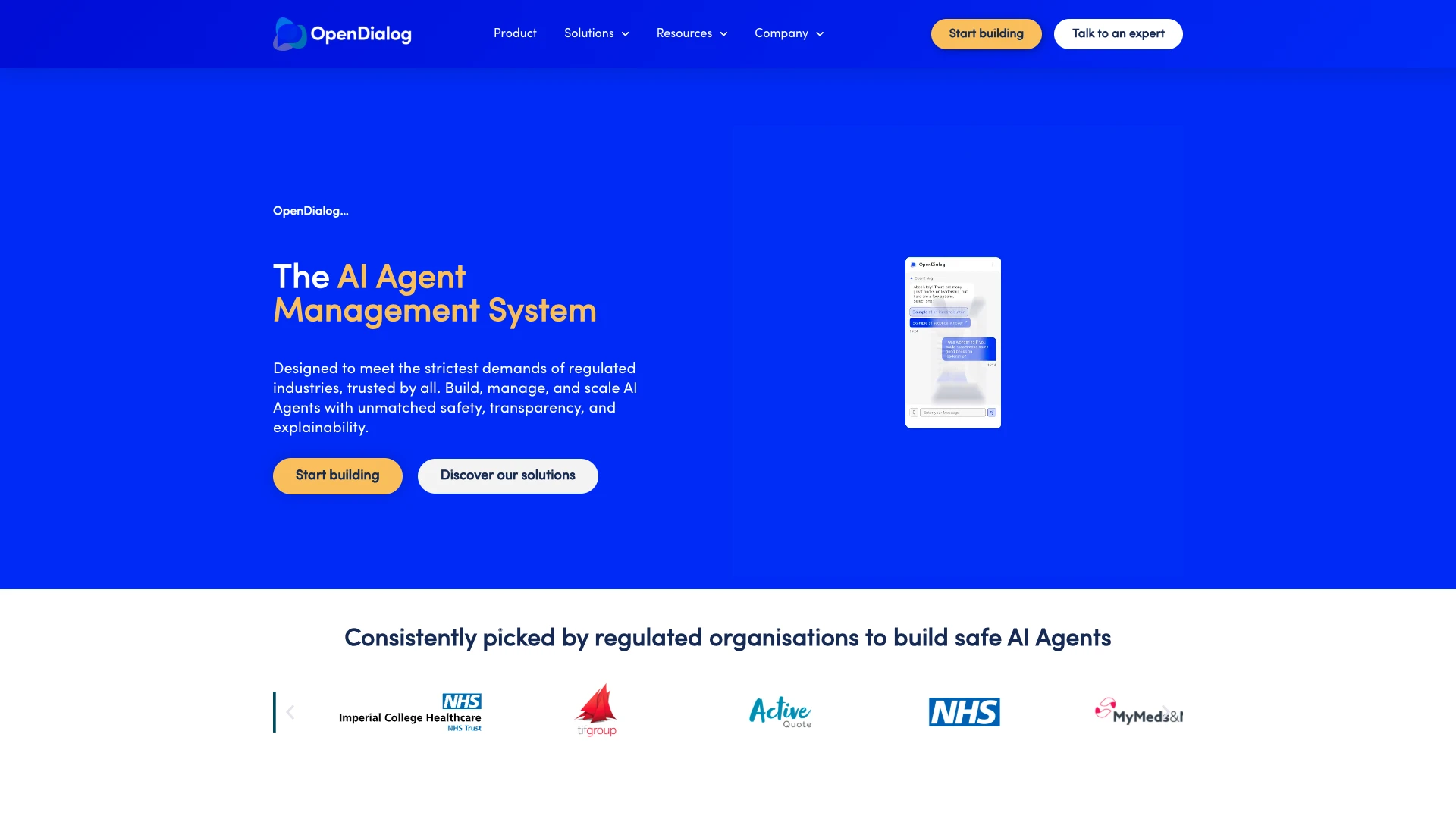
(OpenDialog Website)
Pros
OpenDialog offers an impressive no-code agent builder, enabling even non-technical users to create complex, non-linear conversation flows using visual development tools. It also offers ready-to-use solutions for sensitive industries such as insurance and healthcare.
It also offers a range of tools for performing retrieval augmented generation, semantic classification, and triggering webhook actions, making it fully viable for non-technical colleagues to create working solutions.
OpenDialog offers a high level of auditability, alongside other compliance features such as explainable decision making, helping to position it as a strong offering for heavily regulated industries.
Cons
As it primarily targets no-code users, some teams may find that OpenDialog lacks more advanced customization capabilities that we’d find in other platforms, although we can perform certain tasks via an SDK.
While it does offer out-of-the-box solutions for certain use cases, some teams may find these lacking, especially if they want domain-specific AI tools for the likes of ITSM.
Additionally, some users report issues with technical performance, including occasional sluggish performance.
Pricing
OpenDialog offers a relatively transparent pricing model, with several fixed license tiers. We can use the platform for free with a single test agent.
Paid plans start at $65 per month for a single active agent, with 50,000 steps, 100MB of memory storage, and unlimited LLM tokens. To build more than one agent, we’ll need to pay at least $325 per month.
Customer enterprise licenses offer unlimited usage, 1TB of memory storage, SSO, and access to 24/7 support.
Turn data into action with Budibase
Budibase is the open-source, low-code platform that empowers IT teams to build internal tools on top of any internal data.
We offer connectivity for a huge range of LLMs, RDBMSs, NoSQL tools, APIs, and more, alongside autogenerated UIs, free SSO, custom RBAC, and a powerful automation builder.
Take a look at our features overview to learn more.